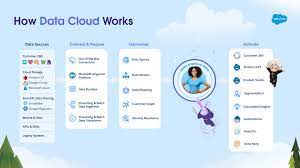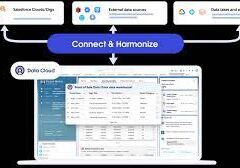Salesforce Data Cloud, previously recognized as Salesforce CDP/Genie, made its debut at Dreamforce 2022, hailed by Salesforce as one of the most significant innovations in the company’s history.
A hyperscale data platform built into Salesforce. Activate all your customer data across Salesforce applications with Data Cloud.
Data Cloud facilitates the intake and storage of real-time data streams on a massive scale, empowering automated tasks that result in highly personalized experiences.
Data can be sourced from diverse Salesforce data outlets, including Mulesoft, Marketing Cloud, and others, along with customers’ proprietary applications and data sources. Subsequently, it can dynamically respond to this real-time data by automating actions across Salesforce CRM, Marketing Cloud, Commerce, and more, inclusive of automating actions through Salesforce Flow.
What is the Salesforce data cloud?
Data Cloud is the fastest growing organically built product in Salesforce’s history (i.e. Salesforce built it themselves, not via acquisitions). Data Cloud could be described as the ‘Holy Grail of CRM’, meaning that the data problem that’s existed since the infancy of CRM is now finally solvable.
Data Cloud is the foundation that speeds up the connectivity between different ‘clouds’ across the platform. However, Data Cloud is also a product that can be purchased. While not all Salesforce customers have licensed Data Cloud, being at the foundation means they are still taking advantage of Data Cloud to a degree – but this all becomes even stronger with Data Cloud as a personalization and data unification platform.
What is the history of Data Cloud?
Salesforce has gone through several iterations with naming its CDP product: Customer 360 Audiences → Salesforce CDP → Marketing Cloud Customer Data Platform → Salesforce Genie → Salesforce Data Cloud.
In some instances, changes were made because the name just didn’t stick – but what’s more important to note, is that some of the name changes were to indicate the significant developments that happened to the product.
- Customer 360 Audiences: Salesforce’s initial CDP offering, launched in 2020.
- Salesforce CDP: The name changed in 2021 to align with how the blooming CDP market was referring to this technology.
- Marketing Cloud Customer Data Platform: In 2022, Salesforce CDP received a new name, as part of the simplification in how Salesforce named their marketing products.
- Salesforce Genie: At Dreamforce the same year, Genie was born. This signified a shift in the use cases (broadening beyond marketing, to sales, service and more), and the zero-copy architecture.
- Data Cloud: In 2023, the name ‘Genie’ was dropped (but not the cute mascot), and Data Cloud has proven itself as a wise investment, partly responsible for powering Salesforce’s GenAI innovation.

Salesforce Data Cloud Differentiators
Data Cloud, in itself, is impressive. While many organizations would consider it expensive, if you were to flip the argument on its head, by buying your own data warehouse, building the star schema, and paying for ongoing compute storage, you’d be looking to spend 5 to 10 times more than what Salesforce is charging for Data Cloud. Plus, data harmonization works best when your CRM data is front and center.
There are other key differentiators that helps Data Cloud to stand out from the crowd:
- Pre-wired to Salesforce objects: While you still need to work to map the systems, and put measures in place to improve/maintain the data quality, the groundwork is done for you.
- Industry-specific data models: Through Salesforce Industries, organizations can use data models and processes designed for their industry needs – as a result, Salesforce are ready to deliver Data Cloud capabilities to a dozen industries. This includes catering to: additional objects in the Data Model, regulatory compliance, and the range of different applications within the verticals.
- Prompt engineering: With harmonized data across your Salesforce database (thanks to Data Cloud), you can leverage your organization’s data for generative AI. Users querying the data using prompts can be applied to a variety of cases. Plus, Salesforce have wowed us (once again) with Prompt Studio, which allows admins to create templates for user prompts, transforming prompts from sentences to buttons. This improves the output that the user would expect by reducing human variation and, by showing a toxicity rating, it ensures that the prompt outputs are coming from reputable sources.
- Einstein Trust Layer: This ‘trust boundary’ aims to resolve concerns over adopting generative AI, including where data is retained when it’s sent to an LLM (large language model). Key features include zero Data Retention and Feedback Store.
Is data cloud a data lakehouse?
That means that Data Cloud is now not just a really good CDP, it’s now a data lake which will be used in sales and service use cases. But it also means that we can start to fundamentally move some of our higher-scale consumer products like Marketing and Commerce onto the platform.
Is Snowflake a data Lakehouse?
Snowflake offers customers the ability to ingest data to a managed repository, in what’s commonly referred to as a data warehouse architecture, but also gives customers the ability to read and write data in cloud object storage, functioning as a data lake query engine.
What is the benefit of Salesforce data cloud?
Data Cloud empowers Salesforce Sales Cloud with AI capabilities and automation that quickly closes deals and boosts productivity across every channel. It drives customer data from all the touchpoints and unifies it separately in individual customer profiles. Salesforce Data Cloud is a powerful data warehouse solution that allows companies to effectively manage and analyze their data.
What is the difference between Salesforce CDP and data lake? Talking abut Salesforce CDP is a little bit like a history lesson.
While a CDP provides a unified, structured view of customer data, a data lake, on the other hand, is more of a raw, unstructured storage repository that holds a vast amount of data (more than just customer data) in its native format until it’s needed.













